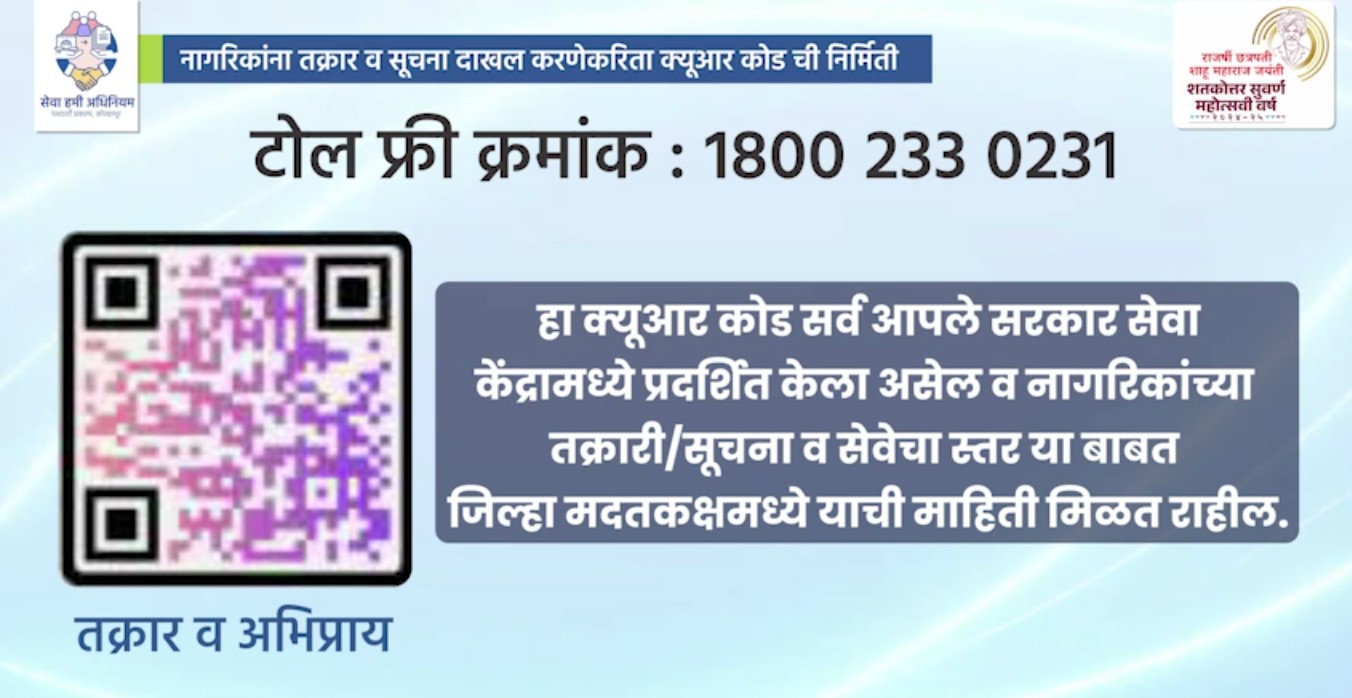Kolhapur District: Pathbreaking Pilot Project for "Right to Services Act, 2015"

Kolhapur District, selected by the Government of
Maharashtra, has implemented a pioneering pilot project under the "Right
to Services Act, 2015" to transform citizen service delivery through
digital innovation. The objective is to ensure that government services are
provided promptly, transparently, and conveniently to citizens at their
doorsteps while fostering trust in the administration.
Key Features of the Project
- WhatsApp
Chatbot for Service Delivery:
A user-friendly WhatsApp chatbot has been introduced to provide citizens with instant access to government services and related information. This tool simplifies service navigation and encourages citizen engagement. - QR
Codes for Feedback and Complaints:
Unique QR codes have been deployed across government offices and service centers to enable citizens to register complaints, share feedback, and submit suggestions directly. This enhances transparency and helps identify and resolve issues promptly. - Door-to-Door
Service Delivery:
A home delivery mechanism has been established to bring government services directly to citizens' doorsteps, reducing the need for physical visits to offices and saving time and travel expenses. - Training
and Capacity Building for Citizens:
Comprehensive training programs are conducted in schools, colleges, and community centers to educate citizens about using the "Right to Services" portal and mobile applications. This initiative empowers citizens to access services independently. - Educational
Camps:
Camps are organized in educational institutions to promote awareness of self-service tools and encourage their use among the younger generation, fostering a culture of digital literacy. - Toll-Free
Citizen Helpline:
A dedicated toll-free help desk has been established to assist citizens with inquiries, complaints, and service-related queries, ensuring seamless communication with the administration. - Service
Center Transformation and ISO Certification:
Existing service centers have been upgraded into model centers, adhering to ISO standards for quality service delivery. This transformation has enhanced operational efficiency and raised service standards.
Project Objectives and Implementation
The project's overarching goal is to digitize citizen
services, improve administrative efficiency, and instill confidence in the
governance system. By implementing a streamlined feedback system through QR
codes and WhatsApp chatbots, the administration collects and resolves
complaints, ensuring quality improvements.
Continuous monitoring mechanisms ensure the effective
delivery of services, while home delivery systems reduce the burden on
citizens. Regular workshops and training programs encourage greater adoption of
self-service applications.
Self-Assessment Against Competition Criteria
- Replicable:
This project serves as a replicable model for other districts and states due to its technology-driven, citizen-centric approach. Features like home delivery of services, QR code-based complaint systems, and WhatsApp chatbots can be easily adapted by other regions to improve service delivery. - Easily
Implementable:
The project is straightforward and cost-effective, requiring minimal technical expertise. With basic training, staff can effectively deploy digital tools and systems. This makes the initiative accessible and implementable across various levels of governance. - Measurable
Outcomes:
The project's success can be tracked through the following metrics: - Speed
of Service Delivery: Measured by the time taken to deliver services.
- Complaint
Resolution Rate: Evaluated based on complaints registered and resolved
through QR codes.
- Citizen
Satisfaction: Assessed through feedback on service quality.
- Training
and Outreach: Tracked via the number of sessions conducted and citizens
trained.
- Self-Service
Applications: Growth in the percentage of citizens using self-service
tools.
- Scalable
Across Levels and Departments:
The project can be scaled seamlessly: - Taluka
Level: Integrating service centers in talukas.
- District
Level: Expanding the model to other departments.
- State
Level: Implementing the system across Maharashtra for widespread
adoption.
- Direct
Citizen Benefits:
- Time
and Cost Savings: Citizens save on travel and waiting time by accessing
services digitally or through doorstep delivery.
- Transparency:
Digital systems ensure transparent processes and real-time status
updates.
- Improved
Service Quality: Citizens receive prompt and efficient services.
- Complaint
Redressal: Quick resolution of grievances through QR code and chatbot
mechanisms.
- Successful
Implementation:
- Service
Centers Upgraded: Transformed into model centers, adhering to ISO
standards.
- High
Citizen Engagement: Over 1,25,436 citizens benefited from doorstep
services in the last ,three months.
- Increased
Chatbot Usage: The WhatsApp chatbot received 1,240 hits for service
inquiries.
- Training
Impact: 345 sessions held in schools and colleges to promote self-service
applications.
- Self-Service
Adoption: A 5% increase in self-service applications, with a target of
20% by 2025.
- Cost
Savings: The digital transformation has reduced operational expenses
significantly.
- Regular
Monitoring: A dedicated team ensures continuous monitoring and reporting
for project improvements.
- Citizen
Feedback Loop: Real-time feedback from QR codes helps improve service
delivery standards.
Conclusion
Kolhapur district's pilot project under the "Right
to Services Act, 2015" is a landmark initiative in citizen service
delivery. By combining technology, training, and outreach, the project has
achieved greater transparency, speed, and quality in service delivery. Its
success has established Kolhapur as a model for other regions, with ongoing
efforts to increase self-service applications by 20% by 2025.
YouTube Link: Watch the
Project Overview



Comments 0 Like 1 Dislike 0